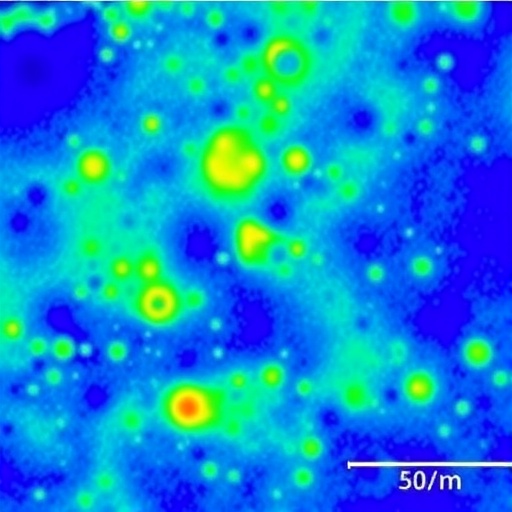Soil health is paramount for sustainable agriculture and environmental monitoring, serving as the foundation for plant growth and the intricate ecosystem relationships that sustain life on Earth. Among various soil properties, soil organic carbon (SOC) stands out as a critical parameter. It plays a pivotal role in carbon cycling, influencing soil fertility, structure, and overall ecosystem health. With the growing concerns surrounding climate change and the ongoing degradation of soil resources, innovative methods for assessing and monitoring SOC have garnered significant scientific interest. In this context, recent research by Xie and Wu sheds light on how soil moisture variation can significantly impact the performance of visible and near-infrared (Vis–NIR) spectroscopy in predicting SOC content.
Visible and near-infrared spectroscopy is a non-destructive analytical technique that utilizes the absorption of light in the visible and near-infrared regions of the electromagnetic spectrum to infer the chemical composition of materials. In soil science, this technique has gained prominence due to its ability to rapidly and accurately assess various soil properties, including SOC content. However, the effectiveness of Vis–NIR spectroscopy is not just a function of the instrumental setup; instead, it is also intricately linked to soil moisture variations, which influence light interaction with soil particles.
The study conducted by Xie and Wu explores the relationship between soil moisture and the performance of Vis–NIR spectroscopy in predicting SOC. Soil moisture, an essential characteristic of soil, can fluctuate based on factors such as precipitation, evaporation, and land management practices. Understanding how these fluctuations affect spectroscopic signals is crucial for developing reliable models that can be employed in diverse environmental conditions. The researchers carried out extensive field and laboratory experiments to assess the variations in spectroscopy responses aligned with different moisture levels.
Xie and Wu meticulously designed their study to evaluate whether variations in soil moisture lead to significant distortions in the spectroscopic data used for SOC estimation. Their experimental approach involved collecting soil samples across different moisture content levels and applying Vis–NIR spectroscopy to investigate how moisture alters the absorption features associated with SOC. By modeling the spectral data against laboratory-measured SOC content, they were able to identify the correlation and potential sources of error introduced by moisture variability.
One of the critical findings from their research indicates that increased soil moisture tends to obscure the absorptive features of SOC, leading to underestimations of SOC content. This observation underscores the complexity of interpreting spectroscopic data, particularly in saturated or near-saturated soil conditions. The researchers highlighted that while Vis–NIR spectroscopy remains an invaluable tool for SOC assessment, researchers and practitioners must be aware of moisture content influences when applying these methods for soil monitoring.
Moreover, Xie and Wu ventured beyond understanding the direct impact of soil moisture on spectroscopy performance. They also delved into potential mitigation strategies to minimize the moisture-induced discrepancies observed in SOC predictions. Their findings advocate for the integration of moisture measurements into SOC prediction models, thereby improving the robustness and accuracy of spectroscopic assessments across diverse soil environments. This approach emphasizes the need for a multi-faceted methodology that combines spectroscopic techniques with soil moisture monitoring.
As climate change continues to alter precipitation patterns, the interdependencies between soil moisture, SOC, and spectroscopic performance become increasingly relevant. The implications of Xie and Wu’s research are profound, suggesting that as environmental changes occur, traditional approaches to SOC estimation may need recalibration. This realignment will not only enhance scientific understanding but also support agronomists and land managers in developing evidence-based soil management practices.
The study serves as a clarion call for further research into the dynamic interactions between soil characteristics and measurement techniques. While Vis–NIR spectroscopy holds significant promise for ecological monitoring and sustainable agricultural practices, it is essential to refine methodologies that account for varying soil conditions. By doing so, the soil science community can advance toward more effective monitoring strategies that encompass the compounding effects of climate variability.
In conclusion, Xie and Wu’s groundbreaking work on soil moisture variations’ impact on Vis–NIR spectroscopy propels the scientific discourse on SOC estimation into new territories. It illustrates the intricate connections between soil health and measurement methods, urging researchers and practitioners alike to adapt their approaches in a changing environment. As the global atmosphere continues to evolve and shift, understanding these interactions will be vital for efforts in sustainable farming, climate mitigation, and ecosystem management.
The implications of this research extend not only to academic pursuits but into practical applications across agricultural landscapes. As soil constituents undergo transformations influenced by moisture levels, assessing SOC through instantaneous methods like Vis–NIR must be seen through a lens that considers external environmental variables. Ultimately, the pursuit of accurate and efficient soil assessments remains critical amidst growing global pressures on food security and land conservation.
In summary, the innovative study conducted by Xie and Wu exemplifies how scientific inquiry can pave the way for enhanced methodologies that address pressing environmental challenges. By revealing the interconnectedness of soil moisture and spectroscopic measurement techniques, their research contributes to a holistic understanding of soil dynamics — a key component in envisaging sustainable futures.
Subject of Research: The impact of soil moisture variation on the performance of visible and near-infrared (Vis–NIR) spectroscopy for predicting soil organic carbon content.
Article Title: Evaluating the impact of soil moisture variation on the performance of visible and near-infrared (Vis–NIR) spectroscopy for predicting soil organic carbon content.
Article References:
Xie, A., Wu, W. Evaluating the impact of soil moisture variation on the performance of visible and near-infrared (Vis–NIR) spectroscopy for predicting soil organic carbon content.
Environ Monit Assess 197, 1221 (2025). https://doi.org/10.1007/s10661-025-14726-8
Image Credits: AI Generated
DOI: 10.1007/s10661-025-14726-8
Keywords: Soil Organic Carbon, Soil Moisture, Visible and Near-Infrared Spectroscopy, Environmental Monitoring, Agricultural Sustainability.




